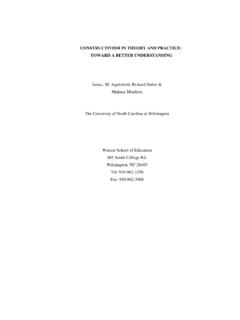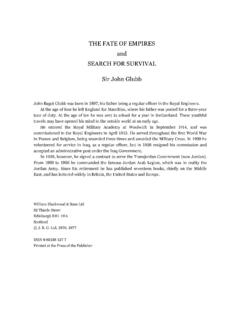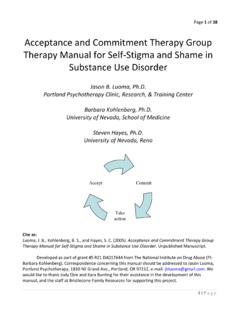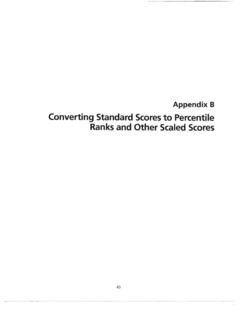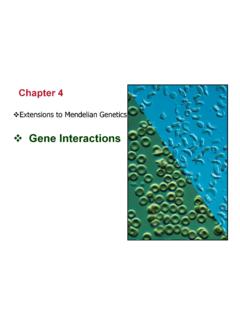Transcription of The Work Preference Inventory: Assessing Intrinsic and ...
1 Journal of Personality and Social Psychology 1994, Vol. 66, No. 5, 950-967 Copyright 1994 by the American Psychological Association, Inc. 0022-3514/94 The work Preference inventory : Assessing Intrinsic and Extrinsic Motivational Orientations Teresa M. Amabile, Karl G. Hill, Beth A. Hennessey, and Elizabeth M. Tighe The work Preference inventory (WPI) is designed to assess individual differences in Intrinsic and extrinsic motivational orientations. Both the college student and the working adult versions aim to capture the major elements of Intrinsic motivation (self-determination, competence, task involve- ment, curiosity, enjoyment, and interest) and extrinsic motivation (concerns with competition, eval- uation, recognition, money or other tangible incentives, and constraint by others).
2 The instrument is scored on two primary scales, each subdivided into 2 secondary scales. The WPI has meaningful factor structures, adequate internal consistency, good short-term test-retest reliability, and good longer term stability. Moreover, WPI scores are related in meaningful ways to other questionnaire and behavioral measures of motivation, as well as personality characteristics, attitudes, and behaviors. Some people seem to be driven by a passionate interest in The "labor of love aspect" driving human behavior is what their work , a deep level of enjoyment and involvement in what psychologists have, for several decades, called Intrinsic motiva- they do. In describing the difference between successful and un- tion: the motivation to engage in work primarily for its own successful scientists, the Nobel laureate Arthur Schawlow re- sake, because the work itself is interesting, engaging, or in some marked, "The labor of love aspect is important.
3 The successful way satisfying. The contrasting concern with "editors and pub- scientists .. are just impelled by curiosity" ("Going for the lishers and critics and the world" fits the definition of extrinsic Gaps," 1982, p. 42). The novelist John Irving similarly ex- motivation: the motivation to work primarily in response to plained his long, intense writing sessions: "The unspoken factor something apart from the work itself, such as reward or recog- is love. The reason I can work so hard at my writing is that it's nition or the dictates of other people. not work for me" (Amabile, 1989a, p. 56). Both the scientist Psychological theory has traditionally been more concerned and the writer describe their driving force as "love." with Intrinsic than extrinsic motivation, in attempts to explain By contrast, some people seem to be motivated more by ex- behaviors such as exploration and challenge seeking, which have ternal inducements in their work .
4 Writing in her private journal, no clear external reinforcements ( , Berlyne, 1971; Harlow, the poet Sylvia Plath attempted to understand her writer's Harlow, & Meyer, 1950; Hunt, 1965; Montgomery, 1954;. block: "Editors and publishers and critics and the w o r l d .. I White, 1959). Contemporary views of Intrinsic motivation in- want acceptance there, to feel my work good and well-taken, clude both cognitive and affective components. Deci and Ryan's which ironically freezes me at my work , corrupts my nunnish (1985a) cognitive evaluation theory posits that self-determina- labor of work -for-itself-as-its-own-reward" (Hughes & McCul- tion and competence are the hallmarks of Intrinsic motivation. lough, 1982, p. 305). Other theorists have proposed the affective components of in- terest and excitement (Izard, 1977); elation and the "flow" of deep task involvement (Csikszentmihalyi, 1975, 1978); and Teresa M.
5 Amabile and Elizabeth M. Tighe (now at Department of happiness, surprise, and fun (Pretty & Seligman, 1983; Reeve, Psychology, Brown University), Department of Psychology, Brandeis Cole, & Olson, 1986). Although views of extrinsic motivation University; Karl G. Hill and Beth A. Hennessey, Department of Psy- are less elaborated, they generally include a cognitive assess- chology, Wellesley College. ment of work as a means to some extrinsic end ( , Calder &. This work was supported in part by a grant entitled "Mechanisms of Staw, 1975;Kruglanski, 1975; Lepper& Greene, 1978). Creativity" from the National Institute of Mental Health (R01 MH- 44999) to Teresa M. Amabile and by a grant entitled "Creativity in the Investigation of individual differences in motivational orien- R&D Laboratory" from the Exxon Education Foundation to Teresa M.
6 Tation is potentially important for both personality and social Amabile. Their support is gratefully acknowledged. psychology. In recent years, social psychological research has We thank Jonathan Cheek and Margie Lachman, who provided valu- revealed that individuals' temporary motivational orientation able suggestions at several stages of this research; Steven Kramer, Rich- toward activities can differ as a function of the social contexts ard Hackman, Martha Picariello, ReginaConti, Mary Ann Collins, and in which they have engaged in those activities ( , Amabile, Heather Coon, who made useful comments on an earlier draft; and sev- DeJong, & Lepper, 1976; Deci, 1971; Lepper, Greene, & Nis- eral colleagues who contributed to data collection or analysis: Heather bett, 1973).
7 Yet clearly, these studies also revealed substantial Coon, Helene Lefkowitz, Francine Esrig, and Sandra Teare at Brandeis University, and Stan Gryskiewicz, Bob Burnside, and Kathleen Holt at variability in the extent to which individuals are affected by so- the Center for Creative Leadership. cial context. There is some recent evidence that such variability Correspondence concerning this article should be addressed to Teresa can be explained, in part, by individual differences in enduring M. Amabile, Department of Psychology, Brandeis University, Waltham, motivational orientations ( , Deci & Ryan, 1985a). Massachusetts 02254. The theoretical assumptions that led us to posit stable indi- 950. work Preference inventory 951. vidual differences in Intrinsic and extrinsic motivation derive havioral consequences of Intrinsic and extrinsic motivational from the intersection of personality and social psychology.
8 In orientations. For example, those who see themselves as strongly recent years, a number of theorists have suggested that behav- intrinsically motivated may strive to select work assignments iors that have been traditionally studied from a social psycho- that allow them to develop new skills, exercise creativity, and logical perspective might profitably be viewed from an individ- become deeply involved in their work . They may also tend to ual-differences perspective, as well. For example, Snyder's see their work environment in terms that support their Intrinsic (1974, 1979) theory of self-monitoring proposed that people's motivation, and they may seek occupations where Intrinsic mo- self-presentation behavior was a function of both their social tivators are salient.
9 On the other hand, individuals who are situation and their enduring orientation toward stability in self- strongly extrinsically motivated may view their work environ- presentation. This proposition has been borne out by empirical ment in terms of its extrinsic controls, and they may seek occu- research. Although Intrinsic and extrinsic motivation have pri- pations where extrinsic motivators are salient. marily been studied as consequences of the social situation, re- It will also be important to examine possible differences in cent theoretical statements suggest that they, too, may exist as the various components of Intrinsic and extrinsic motivation. relatively stable individual differences (Amabile, 1988, 1990). Conceptions of extrinsic motivation include orientations to- Even earlier theoretical statements imply that it is worthwhile ward money, recognition, competition, and the dictates of other to search for individual differences in motivational orientation.
10 People. But there may be meaningful differences between these Bern's self-perception theory (1967, 1972) proposed that, to the components. For example, being oriented toward the dictates of extent that internal states are weak, ambiguous, or uninterpret- other people may be the only component of extrinsic motivation able, individuals must look to their own behavior and the situa- that relates negatively to involvement in creative activities; it is tion in which it occurs to interpret their attitudes and motiva- possible that being oriented toward money bears no relation to tions. This theory has been specifically applied to self-percep- such involvement. Similarly, conceptions of Intrinsic motiva- tions of Intrinsic and extrinsic motivation ( , Lepper et al., tion include challenge, enjoyment, personal enrichment, inter- 1973).
